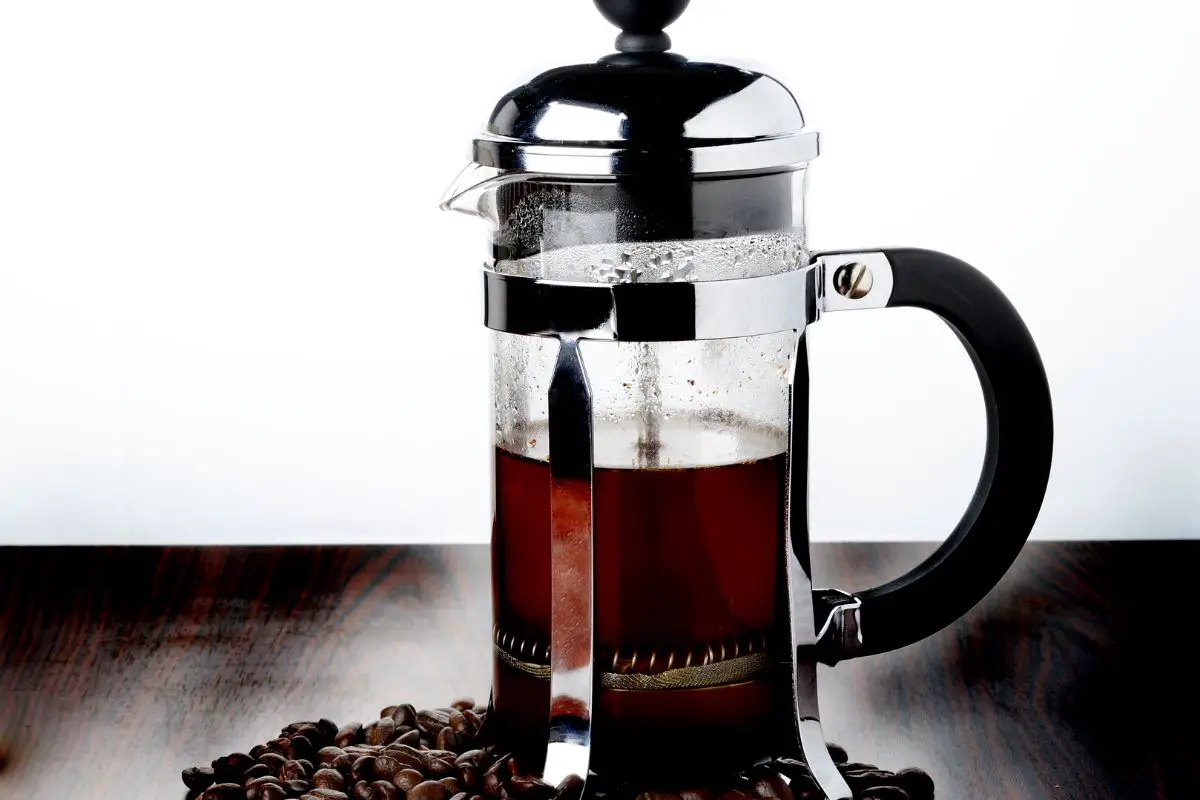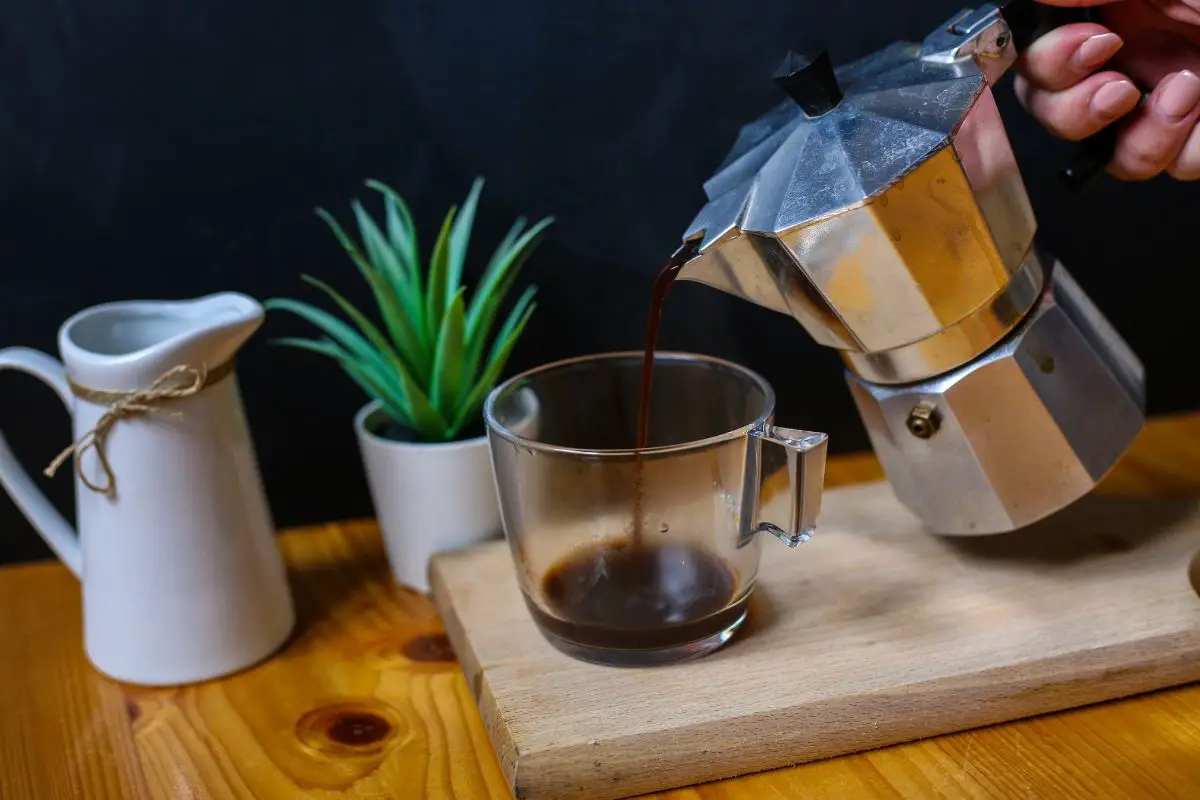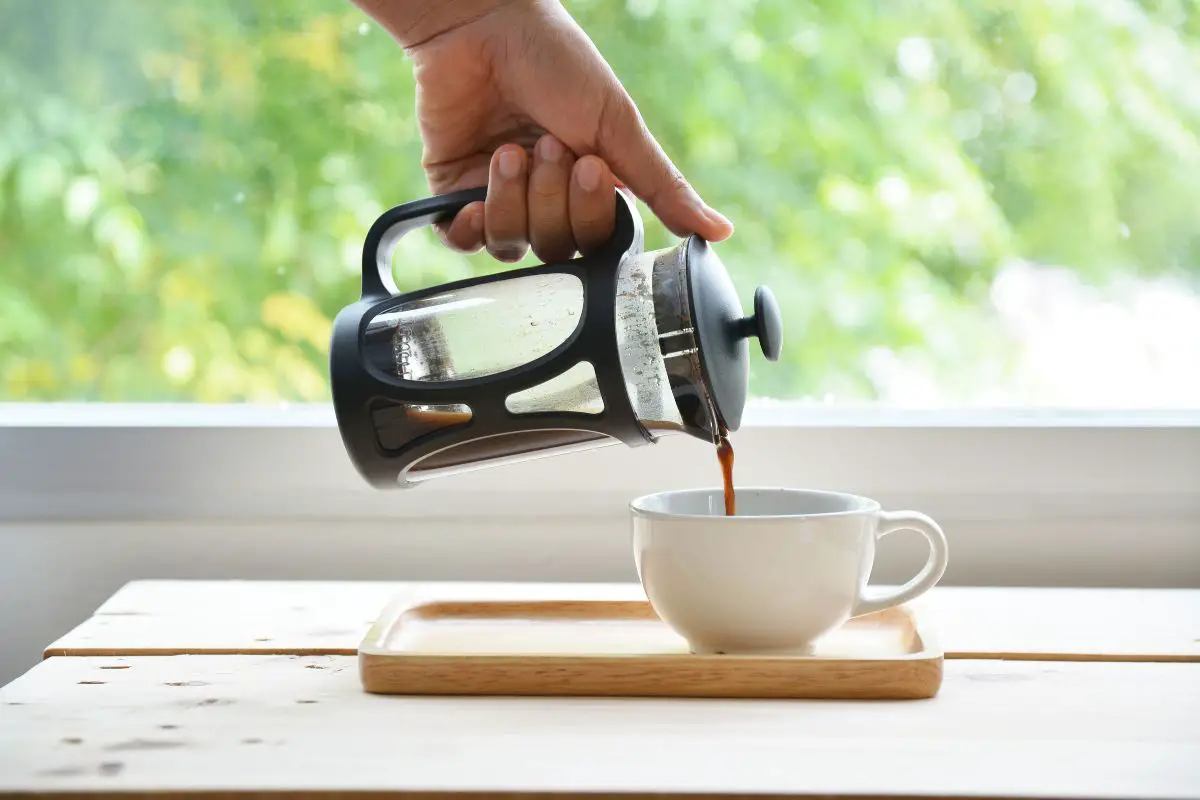In the realm of coffee brewing, the clash between the moka pot and the French press has captivated the attention of coffee enthusiasts worldwide.
These two brewing methods, although distinct in their design and approach, share a common goal: to extract the rich flavors and aromas locked within the coffee beans.

Like two rival contenders in a boxing ring, the moka pot and the French press go head-to-head, each showcasing their unique strengths and weaknesses.
This article will delve into a comprehensive comparison of these brewing techniques, exploring factors such as taste, preparation time, ease of use, portability, versatility, and cleaning and maintenance.
By providing an objective analysis of these two brewing methods, coffee lovers can make an informed decision, ensuring an enjoyable and safe coffee experience.
Key Takeaways
- Moka pot produces a bold and intense flavor similar to espresso, while French press offers a rich and full-bodied flavor with a smooth texture.
- Moka pot takes longer to prepare, while French press has a quicker brewing process.
- Moka pot is known for its simple operation, while French press has a user-friendly design.
- Moka pot is compact and travel-friendly, suitable for on-the-go coffee lovers, while French press offers versatility in brewing different types of coffee.
Brewing Technique Comparison
The brewing techniques of the moka pot and the French press differ in terms of the process and the resulting coffee flavor.
The moka pot, also known as a stovetop espresso maker, consists of a bottom chamber for water, a middle chamber for coffee grounds, and a top chamber for the brewed coffee. The process involves heating the water in the bottom chamber, which creates pressure that pushes the water through the coffee grounds and into the top chamber. This brewing method produces a strong and concentrated coffee with a rich flavor and a thick consistency.
On the other hand, the French press brewing technique involves steeping coffee grounds in hot water and then separating the brewed coffee from the grounds by pressing a plunger down. This process allows the coffee to have greater contact time with the water, resulting in a full-bodied and flavorful brew. The French press is often preferred by those who enjoy a smoother and less concentrated coffee flavor.
In terms of taste comparison, while the moka pot brews a strong and bold coffee, the French press produces a more balanced and nuanced flavor. The choice between these brewing techniques ultimately depends on personal preference and the desired coffee taste.
Taste Comparison
The taste comparison between moka pot coffee and French press coffee reveals distinct flavor profiles.
Moka pot coffee is characterized by a bold and strong flavor, with a robust and intense taste that is often described as being closer to espresso.
On the other hand, French press coffee offers a rich and full-bodied flavor, with a smooth and velvety texture that highlights the natural oils and flavors of the coffee beans.
These different taste profiles can be attributed to the brewing techniques used in each method, which extract different compounds and oils from the coffee grounds, resulting in unique flavor profiles.
Bold and Strong Flavor of Moka Pot Coffee
With its robust and intense flavor reminiscent of dark chocolate and roasted nuts, the coffee brewed from a Moka pot tantalizes the taste buds and invigorates the senses.
This bold and strong flavor is achieved through the unique brewing process of the Moka pot. The water is forced through the coffee grounds at high pressure, extracting the rich oils and flavors from the beans. The result is a concentrated and full-bodied coffee that is both smooth and bitter.
The Moka pot coffee has a distinct and powerful taste that appeals to those who prefer a stronger cup of coffee. However, it is important to note that the strong flavor of Moka pot coffee may not be suitable for everyone, especially those who prefer a milder brew.
Transitioning to the subsequent section on the rich and full-bodied flavor of French press coffee, it is interesting to compare the two brewing methods and their respective taste profiles.
Rich and Full-Bodied Flavor of French Press Coffee
Achieving a rich and full-bodied flavor, the brewing method of French press coffee extracts the essence of the beans, resulting in a sensory experience that evokes images of velvety smoothness and deep, complex undertones.
French press coffee stands out for its ability to capture the natural oils and flavors of the coffee grounds, creating a robust and intense brew. The immersion brewing process of the French press allows for a longer contact time between the water and the coffee, enhancing the extraction of flavors. This method also produces a thicker and heavier texture, giving the coffee a satisfying mouthfeel. Moreover, the metal filter used in the French press allows the coffee’s natural oils to pass through, adding an extra layer of richness to the brew.
Transitioning to the subsequent section about ‘preparation time’, the flavor profile of French press coffee is not compromised despite the longer brewing process.
Preparation Time
Comparing the preparation time between a moka pot and a French press reveals potential differences in brewing speed.
The moka pot, also known as a stovetop espresso maker, typically takes longer to prepare coffee than a French press. This is because the moka pot requires heating water on a stove, which can add a few extra minutes to the brewing process. Additionally, the moka pot needs time to build up pressure and extract the coffee flavors, resulting in a slower overall brewing time.
On the other hand, the French press offers a quicker and more straightforward brewing process. It involves simply adding ground coffee to the press, pouring hot water, and allowing it to steep for a few minutes before pressing down the plunger to separate the brewed coffee from the grounds. This method eliminates the need for additional heating time, making it a faster option compared to the moka pot.
The difference in brewing speed between the moka pot and the French press should be considered depending on one’s individual preferences and time constraints. While the moka pot may take longer, it offers a unique and intense espresso-like flavor. Transitioning to the subsequent section about ‘ease of use,’ the brewing time is just one aspect to consider when deciding between a moka pot and a French press.
Ease of Use
This discussion will focus on the ease of use of both the Moka Pot and the French Press, highlighting the key points of their operation and design.
The Moka Pot is known for its simple and straightforward operation, requiring minimal effort to brew a strong and flavorful coffee.
On the other hand, the French Press is praised for its user-friendly design, with its clear and intuitive instructions allowing for a hassle-free coffee-making experience.
Simple and Straightforward Operation of the Moka Pot

The operation of a Moka pot is characterized by its simplicity and straightforwardness, allowing users to effortlessly prepare a rich and aromatic cup of coffee.
This traditional Italian coffee maker consists of three main parts: a bottom chamber for water, a middle chamber for ground coffee, and a top chamber for the brewed coffee.
The process begins by filling the bottom chamber with water and adding finely ground coffee to the middle chamber. As heat is applied, the water in the bottom chamber boils and creates pressure, forcing the water through the coffee grounds and into the top chamber. This results in a strong and flavorful coffee with a velvety texture.
The Moka pot’s intuitive design and clear mechanisms make it easy for users to operate and enjoy a delicious cup of coffee.
Transitioning to the subsequent section on the user-friendly design of the French press, it is important to explore another popular brewing method.
User-Friendly Design of the French Press
Featuring a sleek and ergonomic design, the French press presents an effortlessly user-friendly brewing method that captures the essence of a freshly brewed cup of coffee. Its simplicity allows for a hassle-free brewing experience, making it a popular choice among coffee enthusiasts. The user-friendly design of the French press is characterized by its straightforward operation and minimalistic construction. With just a few simple steps, users can achieve a rich and flavorful cup of coffee. The table below compares the key features of the French press to the Moka pot, highlighting the user-friendly aspects of the French press.
| French Press | Moka Pot |
|---|---|
| Easy to use | More complex operation |
| Minimal parts | Multiple components |
| No electricity required | Requires a heat source |
| Easy to clean | Requires disassembly and cleaning |
| Durable and portable | Less portable and fragile |
The French press’s user-friendly design, combined with its portability and versatility, makes it an ideal choice for coffee lovers on the go.
Portability and Versatility
This discussion will focus on the portability and versatility of both the moka pot and the French press.
The compact and travel-friendly design of the moka pot makes it an ideal choice for coffee lovers who are often on the go or enjoy camping trips.
On the other hand, the French press offers versatility and can be used not only for brewing coffee but also for steeping tea or infusing flavors in water, making it a multi-purpose tool for those who value functionality.
Both options have unique features that cater to different needs and preferences, providing coffee enthusiasts with a range of choices.
Compact and Travel-Friendly Moka Pot
Compact and travel-friendly, the moka pot allows coffee enthusiasts to enjoy a rich and aromatic brew even when on the go. Its small and lightweight design makes it an ideal choice for those who frequently travel or camp.
The moka pot’s compact size means it takes up minimal space in a suitcase or backpack, making it easy to bring along on trips. Additionally, its sturdy construction ensures that it can withstand the rigors of travel without the risk of breakage.
Moreover, the moka pot is versatile in terms of its heating source, as it can be used on gas stoves, electric stovetops, or even over a campfire. This flexibility allows coffee lovers to enjoy their favorite brew wherever they may be.
In contrast, the french press, while also portable, offers a different set of advantages and features.
Versatile and Multi-Purpose French Press

A versatile and multi-purpose brewing device, the French press offers coffee enthusiasts a range of options for enjoying their favorite brew. With its simple design and easy operation, the French press allows for a customizable brewing process. Users can adjust the brewing time and water temperature to achieve their desired strength and flavor.
Furthermore, the French press can be used to make not only coffee but also tea, hot chocolate, and even cold brew. This makes it a versatile tool for those who enjoy a variety of hot and cold beverages. Additionally, the French press is a great option for those who desire safety, as it eliminates the risk of scalding associated with traditional brewing methods.
Moving on to the next section on cleaning and maintenance, it is essential to keep the French press clean to ensure optimal performance and longevity.
Cleaning and Maintenance
To ensure optimal performance and longevity of both the moka pot and the French press, meticulous and regular cleaning and maintenance are of paramount importance, as neglecting this essential aspect can lead to the accumulation of stubborn residue, compromising the flavor and quality of the brewed coffee to an unimaginable extent.
Cleaning and maintaining a moka pot or a French press should be approached with care and attention to detail. Here are some key steps to follow:
- Disassemble and clean: Take apart the different components of the moka pot or the French press, such as the filter, plunger, and pot, and clean them thoroughly. Use warm water and mild dish soap to remove any coffee grounds, oils, and residue.
- Descale regularly: Over time, mineral deposits can build up inside the moka pot or the French press, affecting the taste and performance. Descaling agents or a mixture of vinegar and water can be used to remove these deposits and maintain the efficiency of the brewing process.
- Dry properly: After cleaning, ensure that all parts are completely dry before reassembling. Moisture can promote the growth of mold or bacteria, which can be harmful if ingested.
Regular cleaning and maintenance not only ensure the safety of your coffee but also extend the lifespan of your moka pot or French press. By following these steps, you can enjoy a delicious cup of coffee while also ensuring the longevity and safety of your brewing equipment.
Frequently Asked Questions
Can I use a moka pot or french press to make cold brew coffee?
Both a moka pot and a French press can be used to make cold brew coffee. However, the process and results may vary. It is important to consider the safety guidelines and follow the instructions provided by the manufacturer to ensure optimal results.
Can I use a moka pot or french press with a stove that has an induction cooktop?
Using a moka pot or French press with an induction cooktop is not recommended due to the absence of direct heat transfer. This could result in inefficient brewing or damage to the cooktop.
Can I use a moka pot or french press to make tea instead of coffee?
Yes, both a moka pot and a French press can be used to make tea instead of coffee. However, it is important to note that the brewing process and flavors may differ from traditional tea-making methods.
Can I use a moka pot or french press to make espresso-like coffee?
Both a moka pot and a French press can produce coffee that resembles espresso, although they have differences. The moka pot uses pressure to extract flavors, while the French press uses immersion. It is important to follow safety guidelines when using these devices.
Can I use a moka pot or french press to make a large batch of coffee for a group of people?
Both the moka pot and French press can produce a large batch of coffee for a group. However, it is important to consider the safety aspect, such as handling hot materials and potential for burns.
Conclusion
In conclusion, after analyzing the brewing technique, taste, preparation time, ease of use, portability, versatility, cleaning, and maintenance aspects of both the moka pot and the French press, it is clear that each method has its own unique qualities.
The moka pot, with its rich and intense flavor, is like a bold and charismatic artist, while the French press, with its smooth and full-bodied taste, is like a refined and sophisticated poet.
Both methods require careful attention and dedication, but the moka pot demands a bit more precision, resembling a skilled surgeon in its brewing process. On the other hand, the French press offers a more relaxed and forgiving experience, much like a tranquil garden where the flavors can bloom freely.
Ultimately, the choice between these two brewing methods boils down to personal preference and the desired coffee experience.
Also read: